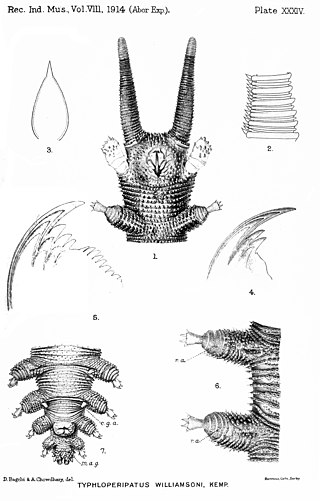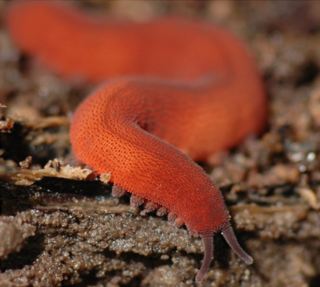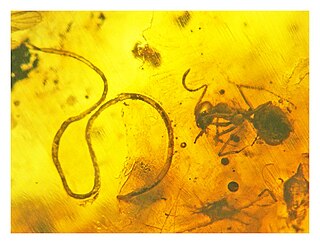
Onychophora, commonly known as velvet worms or more ambiguously as peripatus, is a phylum of elongate, soft-bodied, many-legged animals. In appearance they have variously been compared to worms with legs, caterpillars, and slugs. They prey upon other invertebrates, which they catch by ejecting an adhesive slime. Approximately 200 species of velvet worms have been described, although the true number of species is likely greater. The two extant families of velvet worms are Peripatidae and Peripatopsidae. They show a peculiar distribution, with the peripatids being predominantly equatorial and tropical, while the peripatopsids are all found south of the equator. It is the only phylum within Animalia that is wholly endemic to terrestrial environments, at least among extant members. Velvet worms are generally considered close relatives of the Arthropoda and Tardigrada, with which they form the proposed taxon Panarthropoda. This makes them of palaeontological interest, as they can help reconstruct the ancestral arthropod. Only two fossil species are confidently assigned as onychophorans: Antennipatus from the Late Carboniferous, and Cretoperipatus from the Late Cretaceous, the latter belonging to Peripatidae. In modern zoology, they are particularly renowned for their curious mating behaviours and the bearing of live young in some species.

Xenusion auerswaldae is an early lobopodian known from two specimens found in glacial erratics on the Baltic coast of Germany. They probably originated in the Kalmarsund Sandstone of Southern Sweden, which was deposited in the Lower Cambrian. It is the oldest currently known lobopodian with soft body fossils.

Panarthropoda is a proposed animal clade containing the extant phyla Arthropoda, Tardigrada and Onychophora. Panarthropods also include extinct marine legged worms known as lobopodians ("Lobopodia"), a paraphyletic group where the last common ancestor and basal members (stem-group) of each extant panarthropod phylum are thought to have risen. However the term "Lobopodia" is sometimes expanded to include tardigrades and onychophorans as well.

Cretoperipatus burmiticus is an extinct species of velvet worm that is known from the Burmese amber in Kachin state of Myanmar, originating from the Cenomanian-Turonian stages of the Late Cretaceous.
Plicatoperipatus is a monospecific genus of velvet worm containing the single species Plicatoperipatus jamaicensis. It is endemic to Jamaica. Females of this species can have as many as 43 pairs of legs, the maximum number found in the phylum Onychophora. In a large sample collected in 1988, however, females ranged from 35 to 39 leg pairs, with 37 as the mean and the most common number, and males ranged from 31 to 37 leg pairs, with 35 as the mean and the most common number. This species ranges from 25 mm to 65 mm in length. In the 1988 sample, the mean length for males was 33 mm, and the mean length for mature females was 51 mm. This species is viviparous, with mothers supplying nourishment to their embryos through a placenta.

Leucopatus is a genus of velvet worm in the family Peripatopsidae, containing a single species, the blind velvet worm. It is found in northeast Tasmania, Australia, and is ovoviviparous.

Baltic amber or succinite is amber from the Baltic region, home of its largest known deposits. It was produced sometime during the Eocene epoch, but exactly when is controversial. It has been estimated that this forested region provided the resin for more than 100,000 tons of amber. Today, more than 90% of the world's amber comes from Kaliningrad Oblast of Russia. It is a major source of income for the region; the local Kaliningrad Amber Combine extracted 250 tonnes of it in 2014 and 400 tonnes in 2015. Baltic amber is also found in Poland, as well as the Baltic states.

Typhloperipatus is a genus of velvet worm in the family Peripatidae, containing the sole species Typhloperipatus williamsoni. This genus contains the only species in the phylum Onychophora found in South Asia. This species is also striking in that this velvet worm shows no external trace of eyes, although rudimentary optical vesicles are present internally. This species is also notable for featuring males with the minimum number of legs recorded in any velvet worm in the family Peripatidae.

Peripatidae is a family of velvet worms. This family includes more than 90 described species distributed among 13 genera, but some authorities deem only 80 of these species to be valid. The oldest putative representatives of the family herald from Burmese amber dated to the mid-Cretaceous, around 100 million years ago, with representatives from Dominican and Baltic amber attesting to a broader distribution in the Palaeogene / Neogene; molecular variability suggests that the family's crown group may have arisen in the early Mesozoic.

Peripatopsidae is one of the two living velvet worm families. This family includes more than 140 described species distributed among 41 genera, but some authorities deem only 131 of these species to be valid. The French zoologist Eugène Louis Bouvier proposed this family in 1905 with Peripatopsis as the type genus.
Tertiapatus is an extinct genus of supposed onychophoran known from Dominican amber deposits. The only known species described is Tertiapatus dominicanus. Other authors have doubted its status as an onchyophoran, due to its arthropodized antennae and articulated exoskeleton, which suggests that it is likely an arthropod.

Euperipatoides kanangrensis is a species of velvet worm of the Peripatopsidae family, described in 1996 from specimens collected in Kanangra-Boyd National Park, New South Wales. This species has 15 pairs of legs in both sexes. It is endemic to Australia. The embryonic development of Euperipatoideskanangrensis has been described. This species is viviparous. This species is used as model organism for the last common ancestor of the Panarthropoda. It resembles fossil Cambrian lobopodians.
Micropalaeosoma balticus was reported as an extinct, fossil turbellarian flatworm known from Baltic amber of Kaliningrad, Russia, that lived approximately 40 million years ago. It measured approximately 1.5 mm in length. It was considered the oldest and most complete free-living flatworm body fossil. However, much older flatworm fossils have been reported and it has been re-interpreted as a pseudo-inclusion.

Occiperipatoides is a monospecific genus of velvet worm containing the single species Occiperipatoides gilesii. This genus is ovoviviparous and found in Western Australia. The genus is part of the ancient phylum Onychophora that contains soft-bodied, many-legged relatives of arthropods known commonly as velvet worms.

Euperipatoides rowelli is an ovoviviparous species of velvet worm of the Peripatopsidae family. It is found in New South Wales and the Australian Capital Territory.

Epiperipatus biolleyi is a species of velvet worm in the Peripatidae family. This species is red, without any pattern, on its dorsal surface. Females of this species have 28 to 32 pairs of legs; males have 25 to 30. Females range from 18 mm to 75 mm in length, with a mean length of 52 mm, whereas males range from 18 mm to 55 mm, with a mean length of 38 mm. The type locality is in Costa Rica.

Tasmanipatus barretti, the giant velvet worm, is a species of velvet worm in the Peripatopsidae family. It is the sole species in the genus Tasmanipatus and is ovoviviparous.

Peripatopsis moseleyi is a species of velvet worm in the Peripatopsidae family. Males of this species have 20 to 24 pairs of legs with claws ; females have 19 to 23 pairs of legs with claws. Females range from 11 mm to 75 mm in length, whereas males range from 9 mm to 50 mm. The type locality is in South Africa.

Heydenius is a collective group genus of fossil mermithid nematodes from the Tertiary period that cannot be placed in extant genera.
The Prussian Formation, previously known as the Amber Formation, is a geologic formation in Prussia, today mostly Kaliningrad Oblast that dates to the Eocene. It holds 90% of the world's amber supply and Baltic amber is found exclusively in the Prussian Formation.















